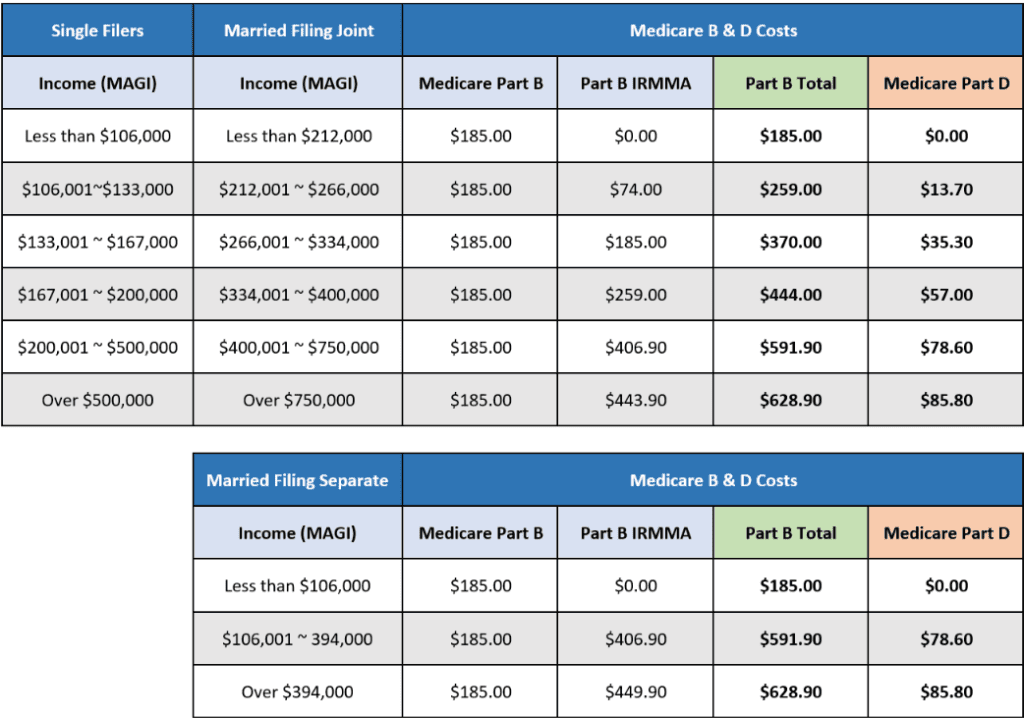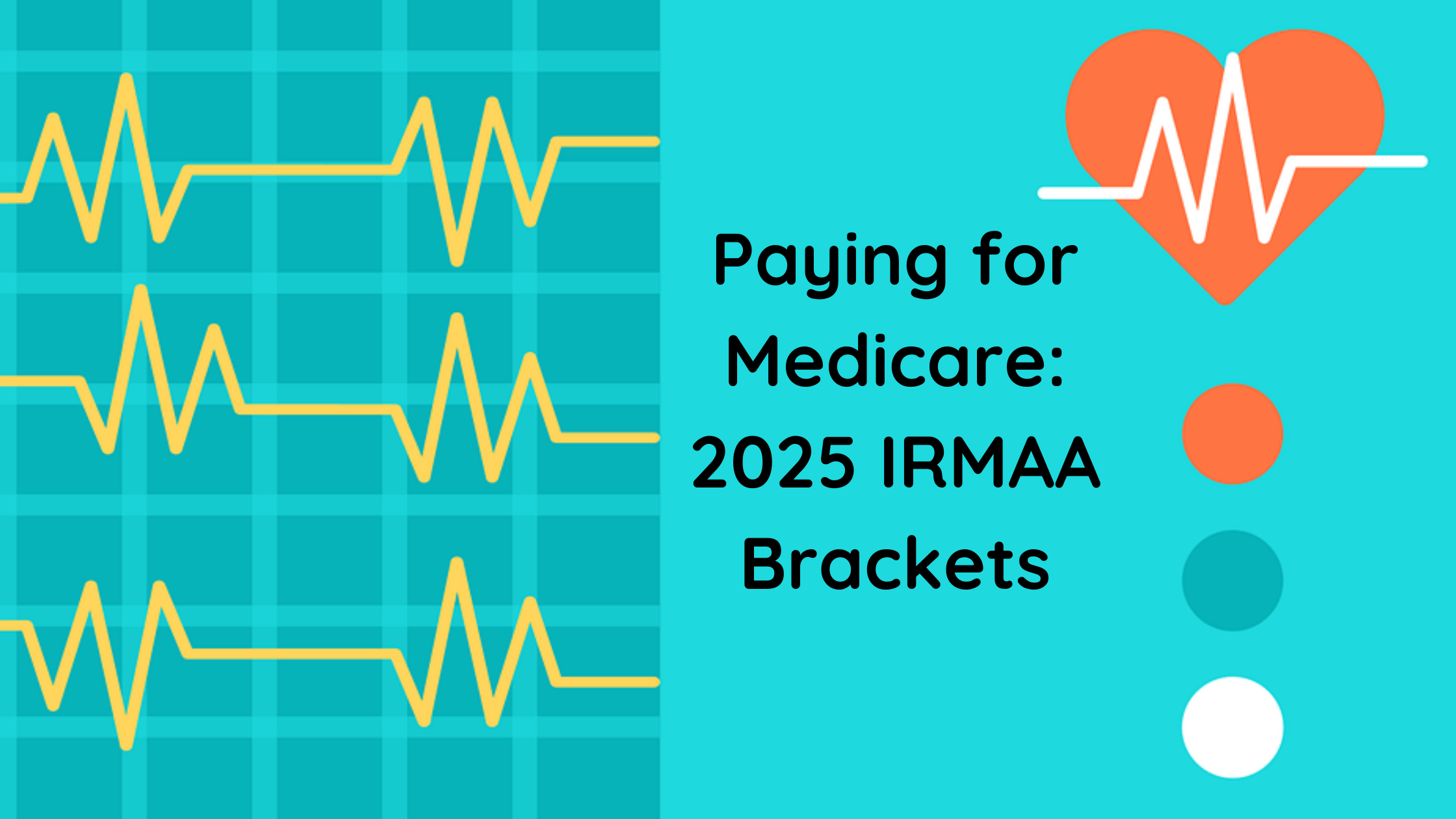The 2025 IRMAA (Income-Related Monthly Adjustment Amount) brackets are out, learn how income-related adjustments can impact Medicare Part B and Part D premiums.
2025 IRMAA Brackets Published: Medicare Part B and D Premiums
The Income-Related Monthly Adjustment Amount (IRMAA) brackets for 2025 have been published. For individuals who are covered by Medicare Part B or Part D and above certain income levels (as reported on their tax return for the 2023 tax year), the cost of their Medicare premiums will include an additional surcharge, meaning they will pay higher premiums than those in lower brackets that don’t trigger the IRMAA in 2025.
The 2025 Medicare Part B and Medicare Part D IRMAA Brackets
Comparing the Five Income Brackets with 2024
As we transition from 2024 to 2025, Medicare beneficiaries should be aware of changes in the IRMAA brackets. Comparing the 2024 and 2025 IRMAA brackets can provide insights into how these adjustments might affect your Medicare premiums. It is important to note that the income level of 2 years prior is used to determine the current year’s monthly premium surcharges. So the Modified Adjusted Gross Income (MAGI) reported to the IRS for the 2023 tax year is what will be used to determine an individual’s 2025 premium for Medicare Part B IRMAA. Those under the recent released income levels will only have to pay the base premium for part B, which will be $185 per month, up from $174.70 in 2024. The income threshold where IRMAA takes effect will rise from $103,000 to $106,000 next year for single tax filers and married individuals who file separately. For married couples who filed a joint tax return in 2023, the IRMAA threshold will rise from $206,000 in 2024 to $212,000 in 2025.
What are the 2025 IRMAA Brackets and How Do They Affect Medicare Premiums?

Understanding the Basics of the IRMAA Income Brackets
The Income-Related Monthly Adjustment Amount, or IRMAA, is an additional charge that high-income Medicare beneficiaries must pay on top of their standard monthly premium for Medicare part B and part D. The surcharge for Medicare Part B is higher than for Part D premiums, and standard. For part D, IRMAA is calculated by the health insurance provider. The chart above shows the 2025 average premiums for high-income beneficiaries of Medicare part D coverage. The IRMAA is based on your Modified Adjusted Gross Income (MAGI) from two years prior. Therefore, for 2025, the IRMAA determination will be based on your income data from 2023. While all Medicare Part B participants pay the base premium, those with IRMAA have to add the surcharge amount to the monthly amount to get their total premium.
Subscribe to the PlanWell Newsletter.
How are 2025 IRMAA Brackets for Part B and Part D Premiums Determined?
The 2025 IRMAA brackets are determined by the Centers for Medicare & Medicaid Services (CMS) and are based on income levels. These brackets categorize beneficiaries into different income ranges, with higher-income individuals paying more in premiums. The income brackets are adjusted annually to reflect inflation and changes in the cost of living.
How Does Modified Adjusted Gross Income Influence IRMAA and Original Medicare Premiums?
Role of Taxable Income in IRMAA Premium
Income tax brackets play a pivotal role in determining the IRMAA for impacted Medicare beneficiaries. These brackets categorize individuals based on their MAGI, with each bracket corresponding to a different level of surcharge. As income increases, so does the IRMAA, leading to higher Medicare premiums.
While Medicare Part D provides prescription drug insurance, Medicare Part B beneficiaries have coverage for outpatient care, doctor visits, and preventive services, too. In 2025, beneficiaries with higher MAGI will see an increase in their monthly Medicare Part B premium due to the IRMAA surcharge. High-income beneficiaries will pay significantly more for their Part B coverage compared to those not subject to IRMAA calculations. If your income exceeded $106,000 (MAGI) on your 2023 taxes, then you can expect some to pay IRMAA on top of your original full part B premium.
Knowledge is Confidence!
What Steps Can Be Taken to Minimize the IRMAA Surcharge?
Modified Adjusted Gross Income (MAGI) is a crucial factor in determining IRMAA and, consequently, Medicare premiums. MAGI includes adjusted gross income plus any tax-exempt interest income. For Medicare purposes, it is used to assess whether a beneficiary falls into a higher income bracket and is subject to the IRMAA surcharge. Understanding how to calculate your MAGI can help you minimize the impact of the IRMAA surcharge on your Medicare premiums. Strategies such as tax-efficient withdrawals from retirement accounts, timing Roth IRA conversions, and making charitable contributions can help keep your MAGI within a lower bracket. Consulting with a financial advisor for federal employees can provide personalized strategies to manage your income effectively and potentially reduce your Medicare costs.
Need help? Contact Us.
Medicare Advantage Plans and Income Management
Changes for Medicare Advantage Plans for 2025
Medicare Advantage plans offer an alternative to traditional Medicare and can help beneficiaries manage their healthcare costs more effectively. These plans often include integrated coverage for Part B and Part D, potentially reducing the impact of the IRMAA surcharge. By exploring Medicare Advantage plans, beneficiaries can find options that align with their healthcare needs and budget, providing a comprehensive approach to managing their Medicare expenses. Even if enrolled in a Medicare Advantage plan, though, you are still subject to IRMAA.
In 2025, Medicare Advantage plans will see several significant changes that could impact your coverage and costs. One of the most notable updates is the introduction of a $2,000 out-of-pocket limit for prescription drugs. Additionally, the infamous “donut hole” coverage gap will be eliminated. Unlike with 2024 Medicare Part D coverage, those who have paid $5030 on prescriptions in 2025 will not be required to pay more for their medicine before reaching catastrophic coverage, which goes into effect after $8000 has been spent.
Income Management Strategies to Reduce IRMAA
Implementing income management strategies can help beneficiaries reduce their IRMAA surcharge. Techniques such as timing income recognition, utilizing tax-efficient investment vehicles, and making charitable contributions can help keep MAGI within lower brackets. By actively managing their income, beneficiaries can potentially lower their future Medicare premiums and reduce the financial burden of the IRMAA surcharge.
Reach Out to Us!
If you have additional federal benefit questions, contact our team of CERTIFIED FINANCIAL PLANNER™ (CFP®) and Chartered Federal Employee Benefits Consultants (ChFEBC℠). At PlanWell, we are federal employee financial advisors with a focus on retirement planning. Learn more about our process designed for the career fed.
Preparing for federal retirement? Check out our scheduled federal retirement workshops. Sign up for our no-cost federal retirement webinars Federal Retirement Workshops! Make sure to plan ahead and reserve your seat for our FERS webinar, held every three weeks. Want to have PlanWell host a federal retirement seminar for your agency? Reach out, and we’ll collaborate with HR to arrange an on-site FERS seminar.
Want to fast-track your federal retirement plan? Skip the FERS webinar and start a one-on-one conversation with a ChFEBC today. You can schedule a one-on-one meeting on our contact page.










